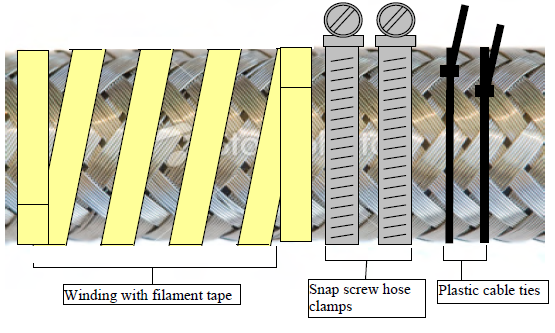P4 corrugated hose in sizes ¼” to 2″ is manufactured and tested in accordance with the ISO 10380 International Standard as Type 2-10 hose. ISO 10380 conformity is another example of Penflex’s commitment to provide exceptional products to our customers.
ISO 10380 is an International Standard which specifies the requirements for the design, manufacture and testing of corrugated metal hoses and hose assemblies for general purposes.
The Standard covers sizes from DN 4 to DN 300 (1/16″ to 12″), Working Pressures from PN 0.5 bar to PN 250 bar (7 psi to 3625 psi), specifies pressure derating factors for elevated temperatures, two methods of construction and three types of flexibility of hose assembly.
For Type 2-10 hoses, the bend radii for testing each hose size is defined by the Standard for both static (Pliable) and dynamic cycling (U-Bend) testing. The pressure in bars for which a hose shall meet all requirements, must be selected from one of the pressures listed in section 5.7.2 of the standard. When cycle tested in a U-bend, hoses shall have an average life of 10,000 cycles.
P4 Products: ISO 10380 Qualifications [Type 2-10 Hose]
Nom
size
(in) |
DN
(mm) |
Part No |
Test
Pressure
(bar) |
Test
Pressure
(psi) |
Static
Radius
Pliable
Test
(mm) |
Static
Radius
Pliable
Test
(in) |
Dynamic
Radius
U-Bend
Test
(mm) |
Dynamic
Radius
U-Bend
Test
(in) |
| 1/4 |
6 |
P4-H40xx-B40xx-004 |
65 |
943 |
25 |
0.98 |
140 |
5.5 |
| 5/16 |
8 |
P4-H40xx-B40xx-005 |
50 |
725 |
32 |
1.26 |
165 |
6.5 |
| 3/8 |
10 |
P4-H40xx-B40xx-006 |
50 |
725 |
38 |
1.50 |
190 |
7.5 |
| 1/2 |
12 |
P4-H40xx-B40xx-008 |
50 |
725 |
45 |
1.77 |
210 |
8.3 |
| 3/4 |
20 |
P4-H40xx-B40xx-012 |
50 |
725 |
70 |
2.76 |
285 |
11.2 |
| 1 |
25 |
P4-H40xx-B40xx-016 |
25 |
363 |
85 |
3.35 |
325 |
12.8 |
| 1-1/4 |
32 |
P4-H40xx-B40xx-020 |
25 |
363 |
105 |
4.13 |
380 |
15.0 |
| 1-1/2 |
40 |
P4-H40xx-B40xx-024 |
20 |
290 |
130 |
5.12 |
430 |
16.9 |
| 2 |
50 |
P4-H40xx-B40xx-032 |
16 |
232 |
160 |
6.30 |
490 |
19.3 |
If you have any questions or comments, please contact us.
Alternatively, if you would like to learn more about our P4 products, please click here.
